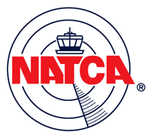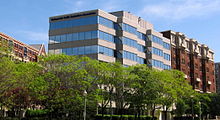- National Air Traffic Controllers Association
-
NATCA 
Full name National Air Traffic Controllers Association Founded 1987 Members 15,000 Country United States Affiliation AFL-CIO, IFATCA Key people Paul Rinaldi, President and Patricia Gilbert, Executive VP Office location Washington, D.C. Website www.natca.org The National Air Traffic Controllers Association (NATCA) is a labor union in the United States. It is affiliated with the AFL-CIO, and is the exclusive bargaining representative for air traffic controllers employed by the Federal Aviation Administration (FAA). It also represents a range of workers related to the Air traffic control (ATC) industry, and the (FAA) itself.
NATCA was formed in 1987, following the decertification of the Professional Air Traffic Controllers Organization (PATCO), the organization involved in the well known 1981 air traffic controllers' strike. NATCA promised to never condone an illegal strike but does actively pressure Congress and the FAA to hire more controllers and to accelerate the installation of advanced air traffic control systems[1].
Internationally, the NATCA is affiliated with the International Federation of Air Traffic Controllers' Associations (IFATCA).
NATCA was involved in contentious negotiations with the FAA in 2005-6 under the Bush administration. Since the parties could not reach an agreement on a new contract, the FAA was forced to follow the process enacted by Congress and unilaterally implement new terms and conditions of employment. [2] The Federal Labor Relations Authority (FLRA) determined that NATCA was treated fairly throughout these contract negotiations and they dismissed all charges made by NATCA that the FAA acted improperly. [3]
Contents
Organization
President
In 2009, Paul Rinaldi was elected the sixth president of NATCA and began his three-year term. Before he became President, he was an air traffic controller for 18 years at Washington-Dulles Tower (IAD) and served three years as NATCA's executive vice president from 2006-2009.
Executive Vice President
In 2009, Trish Gilbert was elected Executive Vice President of NATCA. Before taking this position she spent 20 years as an air traffic controller at Houston Center (ZHU). She led ZHU for three terms as its facility representative and chaired NATCA's Legislative Committee from 2005-2009.
Regional Vice Presidents
There are ten Regional Vice Presidents (RVPs). Each of the FAA’s nine Regions has a Regional Vice President, and the tenth belongs to Region X, which is the region assigned to other professionals that are not air traffic controllers. Engineers, legal professionals, and nurses are the types of workers in Region X. Each RVP is responsibility for certain tasks in their region, including: giving trainings on safety, activism, and labor relations; developing cooperative plans with the FAA regarding alcohol testing, post-incident debriefings; ensuring internal communication; and be the liaison for that regions members by answering questions and attending to daily concerns. The following is the list of the FAA regions and their respective RVP:
-
- Alaskan Region – Larry Lescanec
- Central Region – Kevin Peterson
- Eastern Region – Phil Barbarello
- Great Lakes Region – Bryan Zilonis
- New England Region – Mike Robicheau
- Northwest Mountain Region – Jim Ullmann
- Southern Region – Victor Santore
- Southwest Region – Tim Smith
- Western Pacific Region – Hamid Ghaffari
- Region X – Mike MacDonald
National Office Staff
National Air Traffic Controllers Association headquarters in the Logan Circle neighborhood of Washington, D.C.
The National Office Staff is located at the NATCA National Office in Washington, D.C. The staff is divided into: Executive Office, Accounting, Communication, Contract Administration and Training, Government Affairs, Labor Relations, Membership and Marketing, Safety and Technology.
National Committees
There are eight National Committees, each with their own Respective Duties. The National Communications Committee is responsible for submitting policies regarding the facilitation of IT resources to the National Executive Board. The National Constitution Committee evaluates and takes a position on each proposal to change the NATCA Constitution prior to each convention. The National Election Committee, appointed by the President, sets up and runs the elections, national and regional, every three years. They also must investigate any protests or issues in these elections. The National Finance Committee reviews the salaries of national officers in the union and approves NATCA’s annual budget. They also are responsible for quarterly audits. The National Legislative Committee is the activism and lobbying committee of the union. They organize much of the grassroots efforts for the union, such as year-round lobbying, and establishing and training a network of activists in each region. The National Occupation Safety, Health & Environment Committee provides methods for workers to raise their concerns to the union officials without fear of penalization from either the FAA or other supervisors. The National Office of Worker Compensation Program Committee deals with all injuries on the job as well as training and prevention meetings to ensure safe practices of work. The National Safety Committee deals with safety issues that arise.
Awards
In 2004, NATCA established the Archie League Medal of Safety Awards, named after Archie William League, the first air traffic controller.[4]
Current Issues
FAA Reauthorization Bill
On September 3, 2006 the FAA ceased negotiations with NATCA officials and legally imposed their contract terms on Air Traffic Controllers nationwide. These new terms, which included pay cuts for new controllers and the freezing of current air traffic controllers’ salaries, as well as a sharp change in the working conditions, have had a huge impact on the air traffic controllers. Union officials point to these changes to explain the drastic drop in the numbers of veteran air traffic controllers staying past their eligible retirement age, causing an insufficient staffing issue along with a very bottom-heavy, inexperienced demographic structure of the controllers. The Reauthorization Bill would force the FAA back into negotiations with the NATCA and includes a 15-month limit to the bargaining, followed by arbitration if no consensus is reached. The union hopes that these negotiations will help alleviate the staffing insufficiencies, the increasing amount of delays, and help modernize the air traffic control technology.[5]
Staffing Crisis
As of January 2008, the FAA documented about 11,000 air traffic controllers, which is the lowest number since the 1981 PATCO strike. The union’s position is that this staff shortage relates directly to the 2006 imposed FAA regulations. There are even low numbers at busy facilities, such as Atlanta, Chicago, New York, Dallas, and Southern California, which generally offer a larger salary for controllers, The Union feels that this is a very serious safety concern as it keeps facilities understaffed. However, in regards to the FAA’s position on the suggested safety issue, Hank Krakowski, then-FAA chief of operations, said “there is nothing that we’re seeing at this point in time that gives us any concern.”[6] The belief of the FAA is that the staff shortage affects flight delays more than anything else, and even this is not in significant proportions.
In order to maintain or increase the number of air traffic controllers, the FAA is hiring hundreds of trainees and offering cash bonuses to veteran controllers to entice them to stay beyond their retirement date, but numbers remain low. The Union believes that the decreasing proportion of veteran controllers to new controllers will result in the overworking of veteran leaders, incomplete training of many new controllers, and the increased likelihood of a catastrophic mistake.
Both the US Government Accountability Office and the National Transportation Safety Board have released reports signaling to the FAA that there are problems with the low numbers of controllers, scheduling, and controller fatigue, which will affect the overall job performance of the controllers. The US GAO report to congressional headquarters on Aviation and Runway Safety declared that it is not possible to make sufficient headway with the runway safety concerns “until the human factors issues involving fatigue are addressed.”[7] The Union believes that the fatigue is the result of the decreased number of air traffic controllers, caused by the FAA’s unilaterally enforced policies. They then defer this concern to the National Transportation Safety Board (NTSB), saying, “Air controller fatigue…continues to be a matter of concern for the NTSB”.[7]
As it is a safety concern, the NTSB did release a safety recommendation to both the FAA and the NATCA. The issued recommendation analyzed four controller faulted runway “incursions” where, after investigation, the respective air traffic controller showed signs of fatigue. The report said, “Fatigue is known to degrade performance on cognitive tasks involving working memory and vigilance”, and that the mistakes made by the controllers in the investigated instances were consistent with signs of fatigue. The board attributed this fact to both the shift-work used at most facilities which often does not allow sufficient rest time between shifts, and to the increase amount of overtime worked due to the decrease in controllers.
Delays
Another problem resulting from the staffing crisis is the increased number of flight delays throughout the nation. While the FAA says that these delays are not a result of the insufficient staff problem, 2007 was the second worst year for delays in FAA history. Patrick Forrey, former NATCA President, said that 25% of these delays are due to staffing problems.
References
- ^ Nolan, 1999
- ^ "FAA Reauthorization Act of 1996, Public Law 104-264 Sec 253"
- ^ "FAA Press Release, 2007"
- ^ "NATCA Honors Top Controller Flight Assists with Archie League Medal of Safety Awards". National Air Traffic Controllers Association. March 22, 2010. http://natca.unionlaborworks.com/press_releases.aspx?aID=311. Retrieved 2011-09-18.
- ^ "National Air Traffic Controllers Association". http://www.natca.org/. Retrieved 10 August 2009.
- ^ Conkey, Christopher (6 February 2008). "At Airports, Fewer Eyes on the Skies". The Wall Street Journal. http://online.wsj.com/article/SB120225755774545801.html. Retrieved 10 August 2009.
- ^ a b United States Government Accountability Office (November 2007). "Aviation Runway and Ramp Safety". http://www.gao.gov/highlights/d0829high.pdf. Retrieved 10 August 2009.
External links
- NATCA official website
- http://eightiesclub.tripod.com/id296.htm (PATCO strike of 1981)
- http://www.heritage.org/Research/Reports/2006/05/Winning-the-Fight-to-Curb-Excessive-FAA-Salary-Costs (FAA/NATCA pay and contract history)
- http://lan.natca.net/2009CBA.pdf (Red Book - Current Contract between FAA and NATCA)
- http://www.faa.gov/documentLibrary/media/Order/ATC.pdf (7110.65S Air Traffic Control)
- http://www.faa.gov/documentLibrary/media/Order/ND/3120-4L.pdf (3120.4L Technical Training Order)
AFL–CIO Governance PresidentsGeorge Meany (1955-1979) · Lane Kirkland (1979-1995) · Thomas R. Donahue (1995) · John J. Sweeney (1995-2009) · Richard Trumka (2009- )DepartmentsBuilding and Construction Trades Department · Maritime Trades · Metal Trades · Professional Employees · Transportation Trades · Union LabelConstituency groupsAllied organizationsAllied groupsAmerican Rights at Work · Community Services Network · International Rescue Committee · Jewish Labor Committee · Labor and Working-Class History Association · Working AmericaProgramsAFL-CIO Building Investment Trust · AFL–CIO Employees Federal Credit Union · AFL-CIO Housing Investment Trust · National Labor College · Union PrivilegeAffiliated unions ALPA · ATU · AFGE · AFM · AFSA · AFSCME · AFT · AFTRA · APWU · ATDA · BCTGM · BRS · CSEA · CWA · FLOC · GMPIU · IATSE · Ironworkers · IAFF · AWIU · IAM · Boilermakers · IBEW · IFPTE · ILWU · ILA · Printers & Engravers · Novelty and Production Workers · BAC · IUEC · IUOE · IUPAT · IUPA · MEBA · NATCA · NALC · NFLPA/FPA · NNU · NPMHU · OPEIU · OPCMIA · SIU · SMWIA · TWU · UA · UAW · UMWA · USW · UTU · Roofers and Waterproofers · UWUA · WGAEState federations See also Categories:- AFL–CIO
- Air traffic control in the United States
- Organizations based in Washington, D.C.
- Organizations established in 1987
-
Wikimedia Foundation. 2010.

